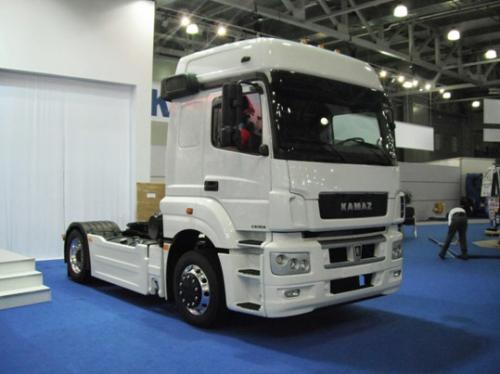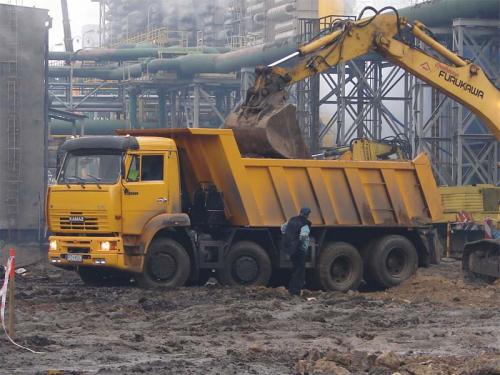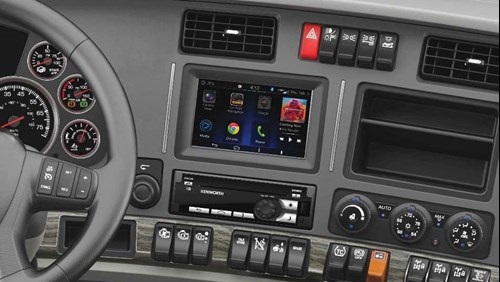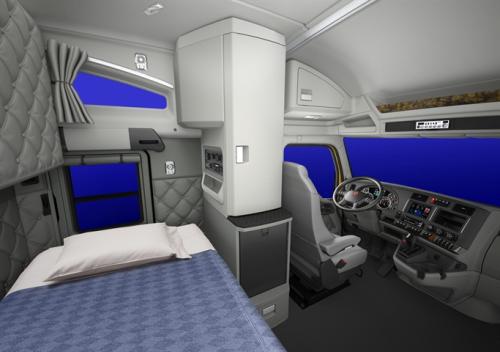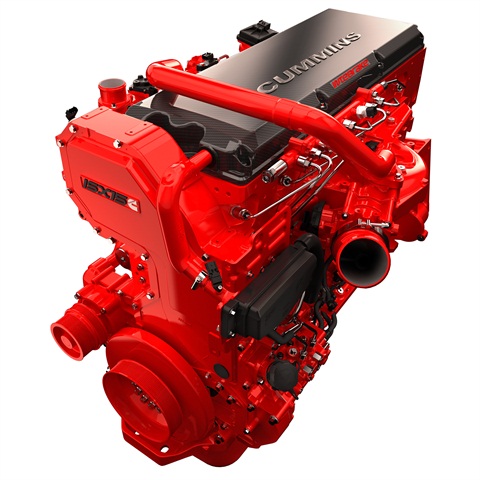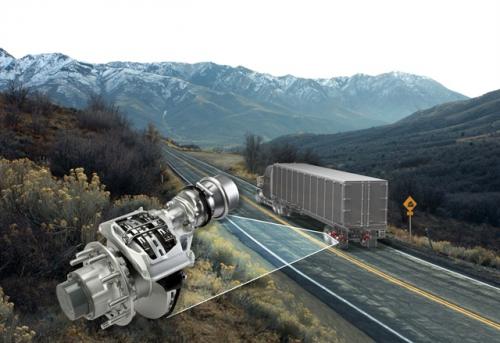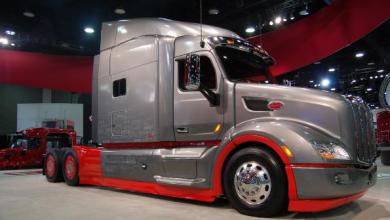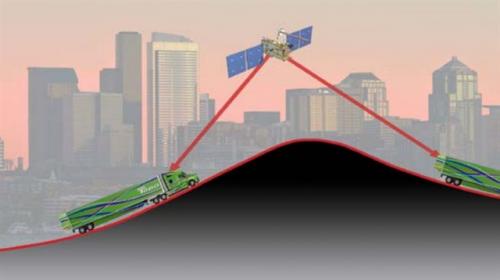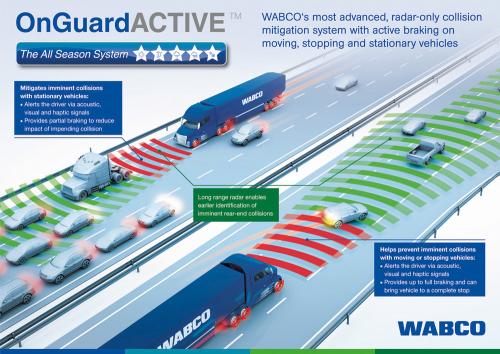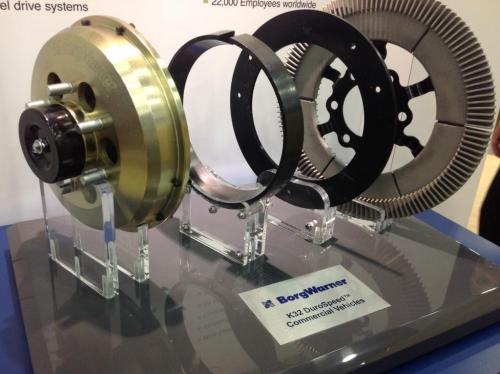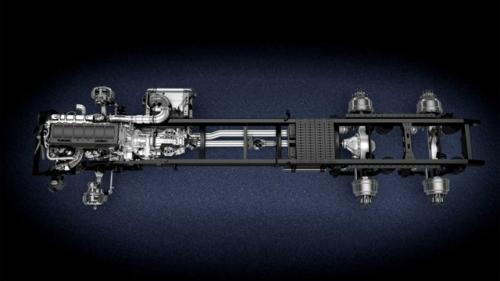
kscarbel2
Moderator-
Posts
18,864 -
Joined
-
Days Won
114
Content Type
Profiles
Forums
Gallery
Events
Blogs
BMT Wiki
Collections
Store
Everything posted by kscarbel2
-
KamAZ Press Release / March 25, 2015 Russian truckmaker KamAZ announced its truck sales for the January-February period in the 14 to 40 metric ton GVW range (30,865lb to 88,185lb) reached 2,300 units, a 48 per cent decline from the same period last year. The company’s market share came in at 52 per cent. During the two month period, overall truck sales in Russia’s 14 to 40 ton GVW segment reached 4,500 units. The company blames the sales decline on a weakened economy, reduction in fixed asset investments, fall in the construction industry output, lower price-per-barrel for Urals crude oil resulting in a sales drop to the petroleum sector, growing inflation and devaluation of the ruble against the dollar and Euro. In addition, the Russian Federation’s central bank significantly raised its key interest rate at the end of last year, reducing Russian companies' access to international financial resources. This led to a decline in the availability of credit and leasing. The sales drop was also caused by the expiration of a government stimulus program that provided customers with up to a US$8,722 discount on new truck purchases. The truck recycling program promoted the replacement of older trucks and buses with newer vehicles offering cleaner exhaust emissions. KamAZ expects the Russian truck market’s 14 to 40 ton GVW segment to reach 51,000 units in 2015. Spurred by sales of its new 5490 Series on-road long-haul tractor range and growing demand for natural gas-powered vehicles in the municipal segment, the truckmaker is forecasting to sell 26,000 thousand vehicles in 2015 and end the year with a 51 per cent market share. With the market condition expected to gradually stabilize, the Central Bank has announced a key rate reduction which will open up more credit and leasing opportunities and support renewed growth in the housing market, agricultural, industrial and fuel-energy sectors. .
-
Green Car Congress / March 25, 2015 The latest Kenworth T680 Advantage—Kenworth’s fuel-efficiency leader—has gained up to 10% in fuel efficiency compared to a standard Kenworth T680 built in 2013. The 10% gain for the heavy-duty truck equates to a yearly savings of more than $4,600 in fuel per truck for the average long-haul operation. The current Kenworth T680 Advantage with 76-inch sleeper features the optimized powertrain combination of the latest PACCAR MX-13 engine with the Eaton Fuller Advantage 10-speed automated transmission, and fuel-efficient drive axles. Also included is the special factory-installed aerodynamic package introduced last year with longer 76-inch sleeper side extenders, lower cab fairing extenders, front air dam, aerodynamic mud flaps, rear fairing without steps coupled with an air deflector, exhaust cut out covers, and optional wheel covers for drive tires. The latest T680 Advantage compares to the 2013 version of the standard Kenworth T680 with 76-inch sleeper, 2013 PACCAR MX-13 prior generation engine, Eaton UltraShift PLUS transmission, and previous generation drive axles. Additional T680 Advantage fuel economy specifications include the Kenworth Idle Management System, tire pressure monitoring system and wide-base tires. It can then make subtle adjustments in speed. For example, it can feather off the throttle automatically when the truck is about to crest a hill. This uses the truck’s momentum to ride up and over, then uses its own weight and momentum to gain speed down the hill without adding power like a static cruise control would provide. Drivers also have always had a huge impact on fuel economy. It’s why we continue to come out with new advancements to help reduce the variability from driver to driver. Our biggest contributor is Kenworth’s new predictive cruise control, which will be an option starting mid-year for new T680s and T880s equipped with the PACCAR MX-13 engine. Thanks to GPS, this predictive cruise control can anticipate the terrain ahead and ensure that the engine and transmission are operating in the most efficient mode. And, based on what the predictive cruise ‘sees’ on the downhill slope, it could automatically tell the transmission to go into neutral coast mode. With this, there is no transmission drag and the truck is free rolling to get back up to speed quicker – again, saving fuel.—Kevin Baney, Kenworth chief engineer Driver assistance for fuel economy. Baney also noted that driver performance is a huge variable in delivered fuel economy, saying that the difference in performance between two drivers with two identical trucks could be up to 30%. At the Mid-America Trucking Show, Kenworth is showcasing four technology advancements that can help to close the fuel economy gap among drivers. Predictive Cruise Control can help drivers obtain even better fuel economy. The Driver Shift Aid and the Driver Reward System can also contribute to improved fuel economy. The Kenworth Driver Performance Assistant, introduced as an option last fall, is now standard on Kenworth T680s and T880s spec’d with the PACCAR MX-13 engine.
-
- 1
-

-
Green Car Congress / March 25, 2015 Kenworth will now offer the Maxwell Technologies ultracapacitor-based Engine Start Module (ESM) as a factory-installed option on new Kenworth T680 and T880 trucks. Kenworth dealers have offered the ESM as an aftermarket solution since 2011. With increasing demand for reliable truck engine starting, Kenworth is now the first truckmaker to offer Maxwell’s ESM as a factory-installed option. Ultracapacitor technology provides high amounts of burst power that is ideally suited for cranking and starting large diesel engines. Additionally, ultracapacitors have a long service life and perform well at cold temperatures. The ESM performs truck engine cranking in temperatures ranging from -40 °F to +149 °F (-40 °C to +65 °C), even when batteries are drained. The ESM replaces one Group 31 format battery in the truck. The ULTRA 31/1800 is designed for Class 7 and 8 trucks, and delivers 1800 cold cranking amps (CCA) and peak power of 32.8 kW. Installed in medium and heavy trucks, it can eliminate jump-starts and reducing idling, resulting in lower total cost of operation.
-
Green Car Congress / March 20, 2015 The US Environmental Protection Agency (EPA) has awarded $8 million to communities in 21 states and Puerto Rico to reduce emissions from the nation’s existing fleet of diesel engines through the agency’s Diesel Emission Reduction Act (DERA) program. The grants will fund projects such as retrofitting older school buses to improve air quality for children riding to school, upgrading marine propulsion and agriculture engines, and replacing long haul truck engines. The twenty-one projects will receive funding through the EPA’s DERA Fiscal Year 2014 allocation. The selected projects are cost-effective and will impact fleets operating in areas that will benefit from additional steps to protect air quality and public health. EPA estimates that every $1 in DERA funding generates up to $13 in health care savings. The DERA funding covers engine replacements, repowers and idle reduction technologies to clean up a variety of older diesel engines, including those in heavy-duty trucks used at ports, delivery trucks, long haul trucks, marine vessels, school buses, and even agricultural equipment. The full list of projects selected for 2014 DERA funds: California. San Joaquin Valley Unified Air Pollution Control District is replacing 48 trucks model year 1991-2003 with trucks powered by 2013 or newer model year engines. South Coast Air Quality Management District is replacing 11 on-road drayage trucks (model year 1991-1995), nine school buses with compressed natural gas (CNG), and one school bus with a battery-electric vehicle.Colorado. Colorado Department of Public Health and Environment is retrofitting 36 school buses with technologies to cut soot and reduce idling. Delaware. Delaware River and Bay Authority is repowering two Tier 0 marine propulsion engines in one vessel with Tier 3 engines. Delaware and Virginia. Mid-Atlantic Regional Air Management Association, Inc. is providing incentives to voluntarily replace 19 drayage trucks operating 1995-2003 engines. Florida and South Carolina. American Lung Association of the Upper Midwest is installing APUs on locomotive switch engines and replacing 12 diesel refuse haulers with CNG haulers. Idaho. Franklin Soil & Water Conservation District is replacing three school buses and four agriculture engines and converting three irrigation pumps to clean burning electric. Illinois, Indiana, Michigan, Minnesota and Wisconsin. Leonardo Academy is retrofitting five trucks, five buses and two excavators with technology to cut soot and reduce idling; replacing eight long haul trucks and three refuse haulers with vehicles that run on compressed natural gas; replacing 14 long-haul trucks and two school buses; and repowering one crusher from Tier 0 to Tier 3. Massachusetts. Conservation Law Foundation (CLF) Ventures, Inc., is repowering two Tier 1 marine propulsion engines with new Tier 3 engines and replacing two generator sets powered with Tier 0 engines with new Tier 3 generator sets. Northeast States for Coordinated Air Use Management is repowering two unregulated fishing boats each with a new Tier 3 engine. Michigan. Southwest Detroit Environmental Vision is replacing five short-haul trucks and one crane. Missouri. St. Louis Clean Cities is replacing six school busses. New Jersey and New York. New Jersey Clean Cities Coalition is repowering seven marine vessels with 13 Tier 3 engines. New York. The Connecticut Maritime Foundation is repowering two Tier 0 marine propulsion engines in one ferry with Tier 3 engines. North Carolina. Mecklenburg County Air Quality is replacing three pieces of landfill equipment and repowering four engines. Oregon. Beyond Toxics is replacing one truck and installing advanced exhaust controls on seven trucks. Puerto Rico. Puerto Rico Metropolitan Bus Authority is retrofitting 17 transit buses with diesel particle filters (DPFs). Texas, Oklahoma and Louisiana. Leonardo Academy is retrofitting school buses with exhaust controls and are retiring eight delivery vehicles early. Texas. North Central Texas Council of Governments is installing EPA-verified SmartWay truck stop electrification at four trucking terminals. Port of Houston is replacing 14 drayage trucks.Utah. Utah Department of Environmental Quality is retrofitting three long-haul trucks with DPF's and retrofit 25 UDOT vehicles with DPFs. EPA is now preparing for the release of the FY15 National Clean Diesel Funding Assistance Program RFP this spring, and anticipates that approximately $12-14 million will be offered under this funding opportunity. Priority will be given to proposals which demonstrate, among other factors: - Diesel emission reductions from engines involved in goods movement; - Diesel emission reductions in areas of poor air quality; - Project outcomes that benefit the community; and - Community engagement and partnerships in the development and implementation of the project.
-
Green Car Congress / March 25, 2015 The California Energy Commissions has selected 9 projects to receive a combined $24,873,512 in proposed funding for cost share in the field demonstration of advanced medium- and heavy-duty on-road vehicle technologies—primarily battery electric and fuel cell technology—that may become commercially available in California. The match amount for the nine projects is $17,212,984. The solicitation (PON-14-605) was under the Alternative and Renewable Fuel and Vehicle Technology Program (ARFVTP). Nineteen other projects also passed the screening. However, the Energy Commission started with the highest score and began determining the awards, descending through the list of finalists until the money available (the $24,873,512) ran out. Five applications did not pass. The nine projects receiving funding are: PON-14-605 proposed awards Lead organization Project Title Cal Energy Funding Transportation Power, Inc. Heavy-Duty Electric Yard Tractors $3,000,000 Transportation Power, Inc. Advanced Battery-Electric Port Vehicles $3,000,000 Transportation Power, Inc. Heavy-Duty Electric Refuse Trucks $2,884,812 Hydrogenics USA, Inc. Hydrogenics Advanced Fuel Cell Vehicle Technology Drayage Truck demo $2,679,417 Hydrogenics USA, Inc. New Flyer Advanced Fuel Cell Vehicle Technology Bus demo $1,739,937 Motiv Power Systems Class C Electric-Quest School Bus Demonstration $2,702,223 Motiv Power Systems Electric Refuse and Loader Truck Demonstration $2,980,875 CALSTART, Inc. LADOT-BYD Battery Transit Bus $2,886,248 North American Repower, LLC The Sectran Security PHEV- Renewal Natural Gas Truck Demonstration Project $3,000,000 Funding of these proposed projects is contingent upon the approval of these projects at a publicly noticed Energy Commission Business Meeting and execution of a grant agreement. If the Energy Commission is unable to timely negotiate and execute a funding agreement with an Applicant, the Energy Commission, at its sole discretion, reserves the right to cancel the pending award. Projects passed, but not funded due to their lower scores, include: CALSTART; H2Ride Hydrogen Shuttle Bus Demonstration Project CALSTART; UPS Advanced Hybrid Lift Truck Demonstration Program City of Gardena - Gardena Municipal Bus Lines; Zero Emission Re-power Efficient Drivetrains, Inc.; PGE PHEV-Renewable Diesel Work Truck Demonstration Project Center for Transportation and the Environment; Fuel Cell Hybrid Electric Delivery Van Project Center for Transportation and the Environment; AC Transit Fuel Cell Bus Power Plant Retrofit Center for Transportation and the Environment; Battery-Electric Mucker Demonstration Project Antelope Valley Transit Authority; AVTA Battery Electric Bus Transit Technology Demonstration Project The Regents of the University of California (Irvine); NextGen American Fuel Cell Bus Project Bay Area Air Quality Management District; Development and Deployment of All-Electric Over The Road Buses Santa Barbara Metropolitan Transit District; SBMTD Advanced Bus Transit Technology Demonstration Project The Leland Stanford Junior University; Stanford University 100% Battery Electric Coach Bus Demonstration Project Caterpillar; Hybrid Wheel Loader With Integrated Technologies Caterpillar; Off-Road Large-Size Hybrid Excavator Phase III Proterra; Extended Range Electric Bus Demonstration Project The Regents of the University of California (Davis); Demonstration of Retrofitted All- Electric Transit Bus at UC Davis Wrightspeed; Turbine-Electric Range-Extended EV Demonstration Vehicles Odyne Systems; Odyne Advanced User Interface Plug-in Hybrid Vehicle Technology Demonstration XL Hybrids; Class 3-4 Advanced HEV Demonstration
-
Cummins claims new ADEPT package to improve ISX15 fuel economy by up to 3% Truck News / March 24, 2015 Cummins announced at the Mid-America Trucking Show that it was planning to “redefine efficiency” and one of its first steps is to release a new technology package dubbed ADEPT, which it says can improve fuel economy by up to 3%. It will debut this summer. The ADEPT package includes a suite of electronic features, which together sense vehicle load, speed and grade and then use the capabilities of the ISX engine and Eaton automated manual transmission to modify the speed, power and gear to maximize efficiency. The system takes advantage of the truck’s momentum to conserve energy and reduce fuel consumption, Cummins officials explained at a press conference on the eve of the Mid-America Trucking Show. “This will help reduce driver-to-driver variability and make each and every driver more efficient and more consistent and turn the fleet operation into a more consistent and efficient operation,” explained Jim Fier, vice-president, engineering, medium-, heavy- and light-duty engine business. One of the features will be SmartCoast, which will disengage the transmission when the truck is travelling downhill, reducing drag on the engine and improving fuel economy. Additional features and technologies will be added later, Fier said. Cummins is also planning noteworthy enhancements to its 2017 ISX15 engine, which will be available with engine ratings from 400-605 hp. It will be offered in two packages: one aimed at fleets looking for efficiency and another designed for fleets and owner/operators who want maximum performance and power. Fier said Cummins is revamping its combustion recipe, developing a more responsive and efficient turbocharger and reducing parasitic losses from within the engine. This will allow for greater downspeeding, he added. The 2017 ISX15 will undergo nine million miles of testing – equal to 4,000 trips from coast to coast within the US. A new ISB6.7 is also coming to the market, featuring an enhanced torque rise, increased fuel efficiency – especially in stop-and-go applications – and greater powertrain integration, as well as natural gas availability, Fier announced.
-
Trucking News / March 25, 2015 Strong Class 8 truck demand is expected to continue through 2015, with production climbing 15-20% over 2014’s healthy volumes. That was the rosy outlook from Joe McAleese, chairman, president and CEO of Bendix. However, he also predicted this year will mark the cyclical market peak, with a drop of 5-15% to follow in 2016. “So we will not have a dramatic drop, just a little softening,” McAleese said during his press address at the Mid-America Trucking Show. Every economic indicator Bendix looks to for hints of future Class 8 truck demand are currently in positive territory. “The overall economic climate our fleets are operating in is a very good economic climate,” McAleese said. The pullback McAleese projects for 2016 is based on the fact 2014 orders finished the year strong, putting pressure on truck production. Despite his upbeat market outlook, McAleese said there are three things keeping him awake at night. These include: the worsening driver shortage, with no end in sight; the impact regulatory changes will have on fleet operating costs and the acquisition costs of new vehicles; and the slow pace of the industry’s acceptance of new safety technologies. Still, McAleese concluded, “2014 was one heckuva year and 2015 is shaping up to be more of the same.”
-
Heavy Duty Trucking / March 25, 2015 Kenworth will begin offering Trucktech+ and Nav+ HD technology products designed to improve vehicle diagnostics and productivity. Trucktech+ tracks and transmits vehicle health in real time while Nav+ HD is a premium multi-function communication and entertainment system, according to the company. Trucktech+ is a real-time truck diagnostic tool provided by PeopleNet. The system will allow the Paccar MX-13 engine to transmit data to fleet managers, call centers and dealers to optimize truck uptime and productivity. The tool will be available for Paccar MX-13 equipped Kenworth Class 8 trucks this summer. Fault codes and engine performance data are sent via the truck's standard modem to Kenworth's analytics center, where possible root causes are diagnosed and solutions are recommended via email notification. Notifications may include keep driving, no action required, keep driving and have the fault addressed during the next service interval, head to a dealer for service, or pull over to prevent damage. When service is required the system will also map out the locations for the three closest repair facilities. The data is also sent to a fleet manager for review along with truck location, status and identified issue and recommended solution. The system is included for the first two years a new Kenworth Class 8 truck is on the road or during the duration of an extended engine warranty period. After that period the tool can be maintained through subscription. Kenworth Nav+ HD is available for Kenworth Class 8 Trucks ordered with Kenworth’s premium interior package and is available as an option for all new Kenworth Class 6-8 conventional trucks. The system centers around a 7-inch, high-definition touchscreen. It includes integration into the Kenworth SmartWheel steering wheel. It offers hands-free Bluetooth phone capability, truck navigation through Co-Pilot, iPod and MP3 integration, integrated Sirius XM Satellite radio, virtual gauges, camera inputs and other features. It also offers Wi-Fi capability. The touchscreen has a pinch-to-zoom feature for several of the apps, for better viewing. In trucks equipped with a rearview camera, the video feed can be integrated into the screen. When Co-Pilot is activated, map updates can be checked for and downloaded through the system as well. .
-
Heavy Duty Trucking / March 25, 2015 Kenworth Truck announced a new 76-inch mid-roof sleeper for its T680 and T880, with production starting in fall. “The Kenworth 76-inch mid-roof sleeper is optimized for liquid bulk tankers, flatbed haulers and other operators looking for a lighter weight, more aerodynamic truck with all the driver comforts of a full-height sleeper,” said Preston Feight, Kenworth general manager and PACCAR vice president. The T680 version is about 100 pounds lighter and can save 5% in fuel compared to a T680 with a high-rood 76-inch sleeper, he said. “For many truck operators, obtaining additional payload capacity can make a big difference in potential profit. The efficient mid-roof design has lower drag, and provides a reduction in fuel expenses,” Feight said. The 76-inch mid-roof sleeper provides drivers with 6.5 feet of headroom to offer taller drivers greater ease of movement, and gives all drivers a spacious work environment. The sleeper features a liftable lower bunk and side storage towers, including hanging storage for drivers to store their clothes. Also available is an optional upper bunk for team drivers or a back wall sleeper storage unit. Available as a factory-installed option is the Kenworth Idle Management System. The battery-based auxiliary power unit system for air conditioning is integrated directly into the ducting system. Combined with an insulation package for the cab and sleeper, the system provides continuous AC performance in typical off-hour downtime. The sleeper offers a premium sound system installed at the factory, or a mount for the customer to install a flat screen TV for even more driver enjoyment. With the new addition, the Kenworth T680 series will include 76-inch mid- and high-roof sleepers, 52-inch mid-roof sleeper, and a day cab. The T880 vocational series will include day cab, 52-inch sleeper and 76-inch mid-roof sleeper configurations. .
-
Cummins previews 2017 15L engine Overdrive / March 25, 2015 Cummins kicked off the Mid-America Trucking Show this week by previewing its 2017 model 15-liter ISX engine, which it says is already fully compliant with the 2017 EPA deadline to reduce greenhouse gas emissions and increase fuel economy. Details remain sparse, of course, but Srikanth Padmanabhan, Vice President of the company’s engine business noted that the ISX15 will feature enhancements including a more efficient turbocharger and reduced parasitic energy loss. The engine will be offered in distinct designs optimized for either performance or fuel economy. Power ratings will range from 400 to 605 horsepower. Cummins also announced changes to its exhaust aftertreatment system, unveiling a new single-module system will debut alongside the 2017 ISX. Srikanth says the new system is an evolutionary design that leverages both customer input as well as Cummins Filtrations’ acquired after-treatment expertise. The system will be 60 percent smaller and 40 percent lighter than current after-treatment systems and will use new catalytic materials and DPF dosing methods to achieve reliable emissions compliance.
-
Heavy Duty Trucking / March 24, 2015 Under the theme of "redefining efficiency," Cummins Tuesday night announced fuel-saving enhancements to the 2015 ISX15 big-bore diesel and a peek at the 2017 ISX15, which will feature a lighter and smaller aftertreatment system along with a more efficient turbocharger and reduced parasitic loss. Srikanth Padmanabhan, vice president of Cummins engine business, explained that while the previous decade of its on-highway business was focused on the environment and emissions, over the next several years it's all about efficiency. And redefining efficiency, he said, is not just for new products, but also for the many Cummins engines already in use. Jim Fier, vice president of engineering for Cummins' heavy/medium/light-duty engine business, noted that the new focus in federal emissions regulations is greenhouse gases and fuel economy. Customers, he said, "are more receptive to that technology" than they were to the numerous rounds of particulate matter and NOx reductions, "and sometimes are in the pull mode." As a result, he said, instead of engine design being a process of coming out with a new emissions-level engine every three years, "it's something we're doing continually." That approach was evident in the announcements made to trucking reporters Tuesday ahead of the Mid-America Trucking Show in Louisville, Ky. 2015 ISX15One key part of Cummins' fuel economy enhancements is the new Adept technology for the ISX15, a suite of electronic engine features Cummins says offers up to a 3% improvement in fuel economy initially for customers operating with automated manual transmissions. Adept uses load-, speed- and grade-sensing technology to make adjustments to speed, power and transmission gear to take advantage of vehicle momentum for better fuel economy. The first package of Adept includes two features: SmartCoast and SmartTorque2 (ST2). SmartCoast operates when the vehicle is coasting downhill by disengaging the driveline and returning the engine to idle to reduce drag, conserve vehicle momentum and, ultimately, improve fuel economy. ST2 uses the same torque management intelligence first introduced on the SmartAdvantage Powertrain to help eliminate unnecessary downshifts and keep the engine operating in the most fuel-efficient “sweet spot.” The first Adept package will be available in summer 2015, and customers will be able to upgrade as future packages are released. Additional features will be announced soon. The 2015 ISX15 also now features NanoNet media lube filtration for better protection and filter life. Also, Cummins has extended the Diesel Particulate Filter cleaning interval to 400,000 miles for line-haul applications that average greater than 5.5 mpg. 2017 ISX15The 2017 ISX15, with a horsepower range from 400 hp to 605 hp, will feature integrated Adept technology. There will be two distinct packages, one optimized for customers seeking maximum fuel economy and the other for premium- and high- performance-oriented fleets. Design updates to the ISX15 for 2017 include a more responsive and efficient turbocharger, further optimization for downspeeding, integrated Adept technology and continued reduction in parasitic loss. Some of the reduction in parasitic loads include less friction in the rings, some auxiliary lube and cooling system improvements that reduce pressure drop, Fier explained. Cummins officials said they also "will continue to push the envelope on extending maintenance intervals" on the 2017 ISX15. The technology will be tested in nearly 9 million miles of real-world experience – the most testing of any product launch to date, according to the company. This is the equivalent of making 4,000 trips coast-to-coast. Another key feature of the 2017 ISX15 engine system is the new Single Module aftertreatment system from Cummins Emission Solutions. This new aftertreatment system for 2017 offers up to 60% reduction in size and space needs and weighs up to 40% less and is more efficient, thanks to advancements in catalyst technologies and urea dosing solutions. Redefining TourCummins will take these new and improved technologies on the road this summer with the Cummins Redefining Tour, featuring a fleet of Cummins ISX15-powered heavy-duty trucks. During the tour, customers will have an opportunity to learn about current and future products and technologies, including Adept technology; Connected Diagnostics, the first application in the suite of Cummins Connected Solutions; real 2017 prototype engines powering the truck fleet, as well as engine system displays representing the product lineup for the North American truck market. More information is available at www.cumminstour.com. .
-
Heavy Duty Trucking / March 25, 2015 Belgium-based Wabco has signed a long-term supply agreement with Hendrickson Trailer Commercial Vehicle Systems to provide advanced air disc brakes for an integrated trailer-axle product with weight-saving potential. As part of the agreement, Wabco will launch its lightweight Maxx22T air disc brake in North America. Maxx22T and Hendrickson axle offers overall weight reduction of up to 100 pounds on tandem axle trailers, helping to improve vehicle fuel efficiency and enabling increased payload, said Nik Varty, Wabco’s president, Americas. Wabco’s single-piston design has approximately 25% fewer parts compared to other air disc brakes available in the market, making it more reliable and lowering maintenance costs for users, he said. A bi-directional adjuster minimizes the risk of hot running brakes. .
-
Heavy Duty Trucking / March 25, 2015 Cummins is showcasing the results of a four-year joint program with the U.S. Department of Energy (DOE) at this week’s Mid-America Trucking Show. The Advanced Technology Light Automotive Systems (ATLAS) program was initiated to develop a commercially viable diesel engine for the half-ton pickup truck market that is capable of meeting future Tier 2 Bin 2 emissions regulations and Corporate Average Fuel Economy (CAFE) and stringent greenhouse gas (GHG) requirements out to the year 2025, according to the company. The demonstration vehicle, provided by Nissan North America, is a 2010 Nissan Titan originally equipped with a gasoline V-8 engine. In addition to meeting fuel-economy and emissions requirements, the new engine needed to accomplish the same work as the large gas V-8, so maintaining a torque output of 385 lb-ft (522 N•m) was necessary. The Cummins team chose a four-cylinder ISF2.8 base engine to begin research, according to the company. “When we launched ATLAS, the team understood that they had to think outside the box to achieve our targets,” said Michael Ruth, director/technical project leader, Advanced Light-Duty. “Specifically, we knew that weight reduction, advanced emissions control technologies, advanced thermal management and powertrain integration would be critical to meeting all of the requirements. The challenge was making those significant advancements while ensuring that the engine we produced would be commercially viable.” The end result after the four-year effort was a 362-lb, 2.8-liter engine with an aluminum block, head and oil pan, a magnesium valve cover and an engine-mounted emissions control system. The ATLAS engine, including the on-engine after-treatment system, weighs in at approximately 80 pounds lighter than the original all-aluminum gasoline V-8, according to the company. The Highway Fuel Economy Test (HFET) and FTP-75 Test (city) cycles demonstrated fuel economy over 35 mpg and 25.5 mpg, respectively. This is approximately a 53-percent increase in CAFE fuel economy at 28.9 mpg, as compared with the production gasoline V-8 fuel economy of 18.9 mpg. The Cummins said its team not only surpassed all fuel-economy targets, but also achieved criteria emissions lower than the stringent Tier 2/Bin 2 GHG levels. The ATLAS engine uses advanced technologies to meet the future regulations. One of the most notable features is the aluminum block. While not visible from outward appearances, the engine is a through-bolt design with a structural cradle above the oil pan and another above the cylinder head, “sandwiching” the block and head and enabling very high cylinder pressure capabilities. A “dual loop” exhaust gas recirculation (EGR) system with both low- and high-pressure circuits and switchable valve timing improve light load emissions output and allow for increased power density of the engine. The overhead camshaft is driven by belt-in-oil technology. This lubricated belt system is designed to last the life of the engine. The ATLAS engine also uses ceramic glow plugs, a high pressure common rail (HPCR) piezo-style fuel system complete with a Bosch high-pressure pump and a VGT™ Turbocharger. The complete package is controlled by Cummins controls technology. Another feature is the engine-mounted after-treatment. In partnership with Johnson Matthey, an on-engine catalyst was developed that has selective catalytic reduction (SCR) wash-coat technology applied directly to the particulate filter. In addition to the state-of-the-art diesel technology, an 8-speed ZF 8HP70 kept the engine operating at an optimum speed, helping to achieve a more than 50 percent fuel-economy improvement over that of the gasoline V-8. The remainder of the truck’s original running gear was unchanged, according to the company. Although the ATLAS engine is a research project, it was subject to all of the design standards and rigorous testing that Cummins performs on all products to ensure that the customer is receiving the most dependable and durable diesel engine available. On-road testing, towing, cold weather and chassis dyno testing, to verify that the ATLAS 2.8L met the U.S. emissions standards it was being measured against, resulted in a successful proof of concept. SAE International recognized the ATLAS team with the John Johnson Outstanding Research in Diesel Engines Award for their work, as published in the SAE paper Thermodynamic Systems for Tier 2 Bin 2 Diesel Engines (papers.sae.org/2013-01-0282), according to the company. Final plans to officially close Project ATLAS include a ride-and-drive event and final presentation at the DOE's 2015 Annual Merit Review, June 8-12 in Arlington, Va.
-
Fleet Owner / March 25, 2015 Peterbilt Motors has two Model 579 Epiq truck models on display this week, both of which feature Goodyear Fuel Max tires. The Epiq package can improve fuel economy by up to 14% through aerodynamic performance, an optimized drivetrain with the Paccar MX-13 engine, and fuel-saving technologies such as low rolling resistance tires, according to Peterbilt. Those tires include Goodyear’s Fuel Max LHD G505D and Fuel Max LHS. “The super-fuel efficiency of these tires makes them a natural fit for display on the Model 579 EPIQ, which is the most fuel-efficient vehicle in Peterbilt’s Model 579 line,” said Gary Medalis, director of marketing, Goodyear Commercial Tire Systems. According to Goodyear, the combination of the Goodyear Fuel Max LHD G505D and the Goodyear Fuel Max LHS saves, on average: $1,300 worth of fuel, per truck, per year, compared to the combination of the Michelin X Line Energy D and Michelin XZA3+ EVERTREAD$560 worth of fuel, per truck, per year, compared to the combination of the Bridgestone M710 Ecopia and Bridgestone R283 Ecopia $560 worth of fuel, per truck, per year, compared to the combination of the Continental EcoPlus HD3 and the Continental HSL2 Eco Plus Both the Goodyear Fuel Max LHD G505D and the Goodyear Fuel Max LHS are SmartWay-verified. .
-
Heavy Duty Trucking / March 25, 2015 The Kenworth Predictive Cruise Control is now standard on Kenworth T680s and T880s with the PACCAR MX-13 engines. The option was originally introduced last fall. The system combines cruise control with GPS information to intelligently monitor speed and improve fuel economy. The system can anticipate hilly terrain and adjust to ensure the engine and transmission are operating in the most efficient mode. The company is showcasing Predictive Cruise Control and three other technologies all designed to improve fuel economy by influencing driving behavior. The other systems are Driver Shift Aid, Driver Performance Assistant and Driver Rewards. Driver Shift Aid provides drivers with a shift-now light, telling a driver when to shift. The system is available on Kenworth models using the PACCAR MX-13 engine with manual transmissions. The tool is designed to optimize shifts and fuel economy based on engine speed. The system can even recommend skip or split shifting if the situation calls for it. The Driver Performance Assistant is a virtual driver’s coach that analyzes how a driver is coasting and braking and gives the driver a score based on that information. The system also gives tips for improving fuel economy with visual feedback and reminder tips when a truck is parked. The system can also be customized and programmed to offer performance settings selected by fleets or owner operators. Tying all of the systems together is Driver Rewards. For fleets that want to, they can reward good driving performance with speed adjustments. If a driver has had positive fuel economy numbers the system can be tuned to reward a driver with increased cruise control. It uses fuel economy and percent idle time and the rewards program can be totally customized by the fleet. .
-
Fleet Owner / March 25, 2015 TRW Automotive Holdings Corp. is displaying its ReAX steering system among other products this week at the Mid-America Trucking Show. ReAX merges two of TRW’s proven steering systems – hydraulic power steering (HPS) for commercial vehicles and electrically powered steering (EPS) belt drive for passenger cars – to improve driver control and stability, it said. “ReAX provides a unique solution reducing the workload on drivers, utilizing traditional hydraulic power steering to provide the torque required to steer larger commercial vehicles while electric power steering offers precision and control. This solution reduces steering efforts at low speeds and yields increased stability at higher speeds,” said Andreas Weller, vice president and general manager-global commercial steering systems. “TRW has more than a decade of experience in combining these two technologies – primarily for bus and motor home applications. Building on that experience, we are now leveraging belt drive EPS to offer a solution for trucks. In addition, ReAX can enable semi-automated driving functions and advanced driver assist systems including lane departure warning and lane keeping assist which can further enhance safety and comfort.” ReAX will be production ready in 2017 for 2018 calendar-year applications, TRW said. The company is also showing off a future technology, ActivMode. This is an energy-efficient hydraulic power steering pump which can deliver an up to 50% reduction in energy consumption compared with traditional pumps in specific configurations. ActivMode achieves its fuel savings and temperature reduction by utilizing unique dual mode flow logic. This flow logic is aligned to match steering system flow demand in the two primary operating states of a commercial vehicle: engine idle and cruising speed. At low engine speed, both sides of the circuit are utilized to provide full flow to meet the demand of the steering system. At cruising speed, one side of the circuit is hydraulically disengaged to minimize pump action and reduce power consumption. “ActivMode is designed for minimum complexity, requiring no electronics or sensors to achieve its unique flow logic. This also helps it to be smaller, lighter and more easily packaged than other energy efficient power steering pumps. Additionally, its ability to operate at lower temperatures can potentially eliminate steering system coolers in many applications. This further reduces system complexity and vehicle weight,” Weller said. “Overall, ActivMode is able to save the equivalent of over 100 gallons of fuel per 120,000 mi. driven.” ActivMode is estimated to be ready for production in 2016 for 2017 calendar year applications.
-
Fleet Owner / March 25, 2015 Wabco is introducing a new radar-based safety system in North America, it said today at the Mid-America Trucking Show here. The OnGuardACTIVEe collision mitigation system offers radar with 30% longer range and its “all season system” leverages 77 GHz radar for improved performance in poor visibility conditions. The company also made a number of other announcements at the show, including an investment in SmartDrive Systems, a plant expansion and a supply agreement with Hendrickson Trailer Commercial Vehicle Systems. According to Wabco, the all season radar system provides performance even in situations such as white outs, heavy rain, dense fog, blinding sunshine or night time driving when camera-based sensors may be impaired. OnGuardACTIVE’s radar offers up to five times higher bandwidth than 24GHz radar-based collision mitigation systems available in the market, the company said. The system’s dual mode function addresses both long range and adjacent lane views for higher accuracy in object detection. OnGuardACTIVE is capable of analyzing traffic up to 650 ft. ahead, thus recognizing impending critical driving situations earlier. Drivers are alerted to potential critical problems via acoustic, visual and haptic signals. Should the driver fail to take corrective action, the system provides active braking on moving, stopping and stationary vehicles to mitigate or prevent impending rear-end collisons. OnGuardACTIVE is capable of delivering up to full braking on moving and stopping vehicles and can bring the vehicle to a complete stop, Wabco said. It can also deliver partial braking on stationary vehicles. “Wabco’s new OnGuardACTIVE is our most advanced collision mitigation system,” said Nik Varty, president, Americas. “Rain or shine, foggy or clear, drivers constantly travel on America’s roads. They need a system that works as hard as they do to keep them and their vehicles safe whatever the season. OnGuardACTIVE’s superior radar technology is up to the task.” OnGuardACTIVE will be sold and supported in North America by Meritor Wabco. Wabco also announced a $20 million investment in SmartDrive Systems, a provider of driving performance management solutions. The companies will jointly develop next-generation, video-based analytics solutions, combining SmartDrive’s real-time, video-based driving performance insights and analytics with Wabco’s advanced braking and stability control technologies. Wabco also noted that its automated manual transmission (AMT) technology continues to increase market penetration both globally and here in North America, posting a 110% increase in sales in 2014. The company also announced a long-term supply agreement with Hendrickson Trailer Commercial Vehicle Systems to provide an advanced air disc brake (ADB) system for trailers in North America. As part of the agreement, Wabco will launch its MAXX22T, an optimized ADB system for trailer applications, in North America. As part of that, Wabco will spend $17 million to build a manufacturing site in Charleston, SC. Construction of the 145,000-sq.-ft. facility is expected to be completed by the end of the year. The company will then relocate from its exiting Charleston site to the new facility. .
-
Fleet Owner / March 25, 2015 Bendix Commercial Vehicle Systems LLC rolled out its new Wingman Fusion driver assistance system (DAS) here at the 2015 Mid America Trucking Show; a system that combines forward-looking cameras, radar, and electronic stability control (ESC) to provide automatic braking for stationary vehicles as well as over-speeding alerts. TJ Thomas, director of marketing and customer solutions for Bendix’s controls group, explains that the combination of camera and radar technologies allows for “computational confirmation” and alert prioritization, among many other new advances. Wingman Fusion – activated at speeds above 15 mph – uses both radar and camera data to plot the position of both moving and stationary metallic vehicles and objects. Thomas said that if the system definitively recognizes a large, stationary, metallic, in-lane object as a vehicle, it notifies the driver up to 3.5 seconds before a potential impact. If the driver takes no action to avoid or mitigate this potentially severe impact, the system can automatically engage the brakes to assist in lessening the severity of, or possibly avoiding, a potential collision altogether, he added. However, Thomas stressed that if the system’s data do not definitively recognize the stationary object as a vehicle, it will alert the driver up to 3 seconds ahead of a potential impact but no deploy the brakes. Wingman Fusion’s over-speeding function can be activated at 37 mph or above and uses the system’s camera to read roadside speed limit signs, working in tandem with Bendix’s electronic stability program (ESP) to alert the driver when the vehicle is traveling a specified amount over the posted limit. The system provides two customizable levels of intervention, he said: Level one, initially set for 5 to 9 mph over the limit, is an audible warning;Level two, if the vehicle is traveling 10 mph or more over the limit, is an audible alert accompanied by a one-second engine de-throttle. Additionally, for a level two speeding event, 20 seconds of video is captured by the system, with 10 seconds of it transmitted wirelessly back to the fleet via Bendix’s SafetyDirect program.“Those speed limit parameters can be adjusted according to a fleet’s policy,” Thomas said, adding that drivers should actually like this feature particularly in road construction areas, where speed limit changes may not be available to navigation devices. He noted that Wingman Fusion is available now to all major North American manufacturers of Class 8 trucks for integration into their vehicle platforms. Thomas stressed that such safety systems are designed to complement safe driving practices and are not intended to enable or encourage aggressive driving. “Responsibility for the safe operation of the vehicle remains with the driver at all times,” he emphasized. Bendix also made several announcements at MATS this year: The new Bendix AD-R Air Dryer is being introduced as a bolt-in replacement solution in the aftermarket, designed to meet the specific air dryer requirements of many Volvo and Mack trucks equipped with remote purge tanks. Well-suited for applications that involve long compressor cycles and frequent starts and stops, the AD-RP is available in two versions: a standard iteration that includes a turbo cut-off valve, with a second model featuring a discharge line unloader compatible with vehicles requiring twin cylinder compressors;The company noted that it’s delivered more than 375,000 Bendix ESP units to date, with expectations of reaching 450,000 by the end of 2015; A new water-cooled, aluminum-crankcase air compressor design is in the works at Bendix, which aims to reduce weight by over 40% compared to the current Bendix BA-921 unit. It also measures 25% less in length while helping increase overall fuel efficiency by reducing power consumption up to 30%; The SmarTire Tire Pressure Monitoring System (TPMS) is being added as a factory-installed option on Freightliner’s Cascadia and Cascadia Evolution models; The company is expanding the reach of its Bendix TABS-6 trailer roll stability system, with a variety of new kits for automatic trailer lift axle control; Finally, 2015 marks the 85th anniversary of Bendix – originally formed in 1930 by the merger of Bendix Aviation Company and Westinghouse Air Brake. Bendix moved its headquarters to Northeast Ohio in 1941, then in 2002 joined the Munich, Germany-based Knorr-Bremse Group.
-
Crain’s Detroit Business / March 24, 2015 Detroit Diesel Corp. plans to upgrade its nearly 75-year-old manufacturing plant in Redford Township. The manufacturer of diesel engines is expected to invest $208 million to add new machinery and equipment for a new medium-duty diesel engine line, creating an anticipated 245 jobs. The Michigan Strategic Fund approved Tuesday a $1.3 million performance-based grant in support of the project. The new grant is in addition to a 2013 grant from MSF for $250,000 for new jobs related to the expansion of a turbocharger line at the Redford Township plant. Detroit Diesel chose to establish the new diesel engine line in Redford over competing locations in Mexico and Germany, the Michigan Economic Development Corp. said in a briefing memo. The supplier, owned by German auto manufacturer Daimler AG, already produces a medium-duty diesel engine in Manheim, Germany, and could have easily placed the new line there, the MEDC said. “With the commitment of state and local support, the company made the decision to place production in Michigan so it will be made under the “Detroit” brand name,” the briefing memo said. The project is expected to begin before the second quarter of this year.
-
BorgWarner introduces K32 two-speed fan drive conversion
kscarbel2 replied to kscarbel2's topic in Trucking News
BorgWarner introduces DuroSpeed 2-speed fan drive Durable, modular, light-weight; for vocational, off-highway applications Fleet Owner / March 25, 2015 BorgWarner’s new DuroSpeed 2-speed fan drive is specifically designed to deliver reliable cooling for severe operating and vocational truck applications such as construction vehicles and municipal trucks. While on/off models provide superb durability and fuel efficiency for over-the-road applications, BorgWarner’s DuroSpeed fan drive significantly reduces fan engagements for greater reliability and less noise in severe service applications, the company says. The modular design allows any BorgWarner Kysor on/off fan drive to be easily converted to a DuroSpeed fan drive. BorgWarner will begin supplying this product in May 2015. “Dump trucks, refuse haulers and other vocational applications experience severe service and have very different cooling needs than line haul trucks. At BorgWarner, our engineers listened to the voice of the customer to develop a simple, efficient design built for durability and serviceability,” said Daniel Paterra, president and GM, BorgWarner Thermal Systems. “Our testing shows the DuroSpeed fan drive’s innovative flux ring design enables this clutch to run 70 degrees Fahrenheit cooler than competitive offerings. The cooler internal operating temperature increases bearing and liner durability, allowing nearly twice as many engagements over its lifetime.” In severe-duty applications, on/off fan drives are continually engaging and disengaging. When disengaged, engine temperatures rise quickly, causing the clutch to engage repeatedly. BorgWarner’s pneumatically actuated DuroSpeed 2-speed fan drive, however, is designed with a higher disengaged fan speed to prevent engine temperatures from rising too quickly. Because the fan drive engages and disengages less often, clutch life increases, noise decreases, dust buildup in the radiator is minimized and more horsepower is available, allowing the vehicle to achieve higher work output. Compared with competitive models, the DuroSpeed fan drive has no spinning air connections to wear, inspect or service, and is designed to operate at lower temperatures for longer bearing and liner life. Weighing 5 to 10 pounds less and using 11 fewer components than comparable units, BorgWarner’s DuroSpeed fan drive also helps deliver better fuel economy. To reduce complexity and minimize upgrade costs, BorgWarner’s modular design uses the same clutch unit for all applications. Any Kysor on/off fan drive can be easily retrofitted to a DuroSpeed fan drive with a conversion kit consisting of only two add-on components. BorgWarner’s new DuroSpeed 2-speed fan drive significantly reduces fan engagements for less noise and longer durability -
Overdrive / March 25, 2015 Building on the popularity of its on-off fan drive, the K32, BorgWarner’s two-speed variant will be available in April as an option from truck manufacturers as well as a conversion kit for operators current utilizing the on-off clutch. Applicable mostly for vocational and/or stop and go applications, where frequent engagement of the on-off clutch could lead to excessive wear of components, the K32 Durospeed boosts disengaged speed for greater cooling effect when not at full engagement. Today, noted BorgWarner Account Manager Lance Wildman, on-off or variable speed fan drives (like the BW Vistronic variable) in linehaul and vocational applications are quite common. Two-speed drives, however, Wildman expects, will dominate vocational applications within the next five years, given the elevated cooling you get when disengaged. Built on the back of the K32 on-off, which Livingston described as “industry standard” in the on-off realm, the K32 Durospeed is made in the United States and built for ease of maintenance. Line and seal service kits are available for regular service. Conversion from any of BorgWarner’s “on-off fan drives that are in the field today” is a relatively simple matter, he added. .
-
Commercial Carrier Journal (CCJ) / March 25, 2015 Cummins offered a peek at its 2017 greenhouse gas engine technology at the inaugural press conference at the 2015 Mid-America Trucking Show. Details remain sparse, of course, but Srikanth Padmanabhan, vice president of the company’s engine business noted that the ISX15 will feature enhancements including a more efficient turbocharger and reduced parasitic energy loss. The engine will be offered in distinct designs optimized for either performance or fuel economy. Power ratings will range from 400 to 605 horsepower. Cummins will also offer new technology downstream from the engine. A new single-module exhaust after-treatment system will also debut in 2017. Srikanth says the new system is an evolutionary design that leverages both customer input as well as Cummins Filtrations’ acquired after-treatment expertise. The system will be 60 percent smaller and 40 percent lighter than current after-treatment systems and will use new catalytic materials and DPF dosing methods to achieve reliable emissions compliance. Cross-country Road Tour The engine maker also announced it will be taking more than 10 Cummins-powered trucks from various truck OEMs on a cross-country road tour to put the company’s latest technology on display, including the 2017 ISX, its SmartAdvantage powertrain, its new ADEPT powertrain, its natural gas engine offerings and its latest telematics system. Connected Diagnostic program Cummins also announced the first in a series of new telematics features with the launch of its Connected Diagnostic program, which will use existing telematic providers such as Omnitracs and PeopleNet to provide fleets with real-time maintenance information. ADEPT software package Driver efficiency was also addressed with the introduction of the ADEPT software package which further optimizes the SmartAdvantage integrated drivetrain (developed in conjunction with Eaton). ADEPT will be offered in various packages, each one designed to better manage engine torque and smooth out driver performance “variability” across fleets. Half of commercial engines powered by Cummins engines In business news, Dave Crompton, president of Cummins engine business, noted that more than 50 percent of all commercial engines in the United States today are powered by Cummins medium- and heavy-duty engines. Crompton said Cummins earned $19.2 billion last year, with 56 percent of that revenue coming from its North American operations. Crompton was upbeat about the current state of the trucking industry, saying that “the market is in much better shape over the last 12 months. It’s a strong market and we are in a strong position in it. We are mindful that the industry is going through a transition, and we have every intention of investing to maintain that leadership position going forward.”
-
Heavy Duty Trucking / March 25, 2015 Detroit Diesel began production of the components making up the integrated Detroit Powertrain, the company announced at the Mid-America Trucking Show. The integrated powertrain will include the Detroit DD15 engine, DT12 automated manual direct drive transmission and Detroit front and rear axles. Every component was designed to work together in an integrated system, says Detroit. The integrated powertrain is available on the Freightliner Cascadia Evolution and the Western Star 5700XE. The Detroit DD15 Engine is rated at 400 horsepower and 1,750 lb.-ft. of torque and was downsped to shift the usable torque range to lower engine speeds. This reduces friction losses, enhances fuel consumption and can improve reliability. The DT12 automated manual transmission comes with Intelligent Powertrain Management which uses pre-loaded terrain maps and GPS to read the route ahead and adjust the shift points to improve function and efficiency. The front and rear axles are offered in a 6x2 configuration with a 2.28 ratio that is designed to work with the downsped engine rating. The 6x2 Detroit axle configuration incorporates a non-driven tag axle on the tandem, reducing total weight by almost 400 pounds while a new 2.41 ratio in its 6x4 axle configuration is also available for applications requiring additional traction. For more information on the integrated powertrain, click here. .
-
Transport Topics / March 25, 2015 Peterbilt Motors Co. unveiled a series of truck improvements and customer-convenience options in the middle of what executives said could be the second- or third-best sales year ever. The Denton, Texas-based unit of Paccar Inc. also is working on autonomous vehicles, saying that platooning to save fuel would be the ideal application. The Peterbilt event was part of the Mid-America Trucking show here March 25. “The industry has come back in a big way. We expect 2015 to be a great year,” said Robert Woodall, Peterbilt assistant general manager for sales and marketing. Paccar is expecting industrywide sales of 250,000 to 280,000 units in North America this year, which would place 2015 behind 2006 and run neck-and-neck with 2005. For vocational vehicles, Model 567 is coming out with a set-forward front axle that would distribute weight more broadly and “be good for mixers and other weight-sensitive applications,” company General Manager Darrin Siver said. For customer convenience, Siver talked about Rapid Check and SmartLinq, two programs that can take note of a truck maintenance problem, help to diagnose it and then quickly set in motion a process to fix it. On autonomous vehicles, he said generating “comfort with them from the public” will be the biggest challenge to getting them on the road. Longhaul applications, including platooning where a caravan in close formation drives down a highway, are “a long way off.” Platooning saves money on fuel because the caravans have less wind resistance. Siver said short trips within a closed facility would be a better start for autonomous vehicles. The company announced two changes for its Model 579: a new 58-inch sleeper cab and improvements to its Epiq fuel economy package. On the Paccar level, Siver said Landon Sproull, the company’s chief engineer for a decade, is now the general manager of Paccar’s engine division. One of Sproull’s early responsibilities will be to lead the MX-11 into production, which is expected early next year, Siver said. Peterbilt also is adding two natural-gas options to its lineup, Model 579 using LNG, and 337 with CNG. Two years ago, natural gas was popular because it was so inexpensive relative to diesel fuel. Now with the drop in diesel prices, that is less so. “The price of diesel has come down, but oil is very cyclical,” Siver said. He thinks natural gas can keep a market share of 5% to 10%, especially if oil climbs again.
-
Transport Topics / March 25, 2015 Daimler Trucks North America said its Freightliner SuperTruck has achieved 115% freight-efficiency improvement, more than doubling the Department of Energy’s goal of 50% improvement. The announcement was made here March 25 at the Mid-America Trucking Show, and the Portland, Oregon-based truck maker displayed the concept vehicle as the centerpiece of its exhibit space. DTNA said its final SuperTruck demonstrator ran a five-day, 312-mile round trip on Interstate 35 between San Antonio and Dallas. Running at a weight of 65,000 pounds and a speed of 65 mph, the truck achieved an average result of 12.2 miles per gallon. During the SuperTruck’s unveling, Diane Hames, DTNA’s general manager of marketing and strategy, described the project as a “playground for our engineers to come up with new ideas and explore things that we wouldn’t necessarily have been able to do otherwise.” The SuperTruck features many ideas that DTNA can use and integrate into future products, she said. Several technologies developed in conjunction with the program have been introduced in the Freightliner Cascadia Evolution, including aerodynamic components and the integrated Detroit powertrain. It also explored other technologies such as mirror cameras and an articulating grille that opens during low-speed and high-torque conditions to maximize cooling flow and automatically closes at highway speeds to reduce aerodynamic drag. “We are thrilled with the positive results and are honored to have been part of the program,” said Derek Rotz, principal investigator for SuperTruck at DTNA. “It is our expectation that we will continue to review and refine what we’ve learned and achieved over the course of the SuperTruck initiative and use that knowledge to bolster our leadership in fuel efficiency.” DTNA’s SuperTruck program was funded through a $40 million DOE grant and a matching investment from the company. DOE’s SuperTruck program was a five-year research and development initiative to improve freight efficiency by at least 50%, brake thermal efficiency by 50% and reduce fuel consumption and greenhouse-gas emissions of Class 8 trucks.
BigMackTrucks.com
BigMackTrucks.com is a support forum for antique, classic and modern Mack Trucks! The forum is owned and maintained by Watt's Truck Center, Inc. an independent, full service Mack dealer. The forums are not affiliated with Mack Trucks, Inc.
Our Vendors and Advertisers
Thank you for your support!


